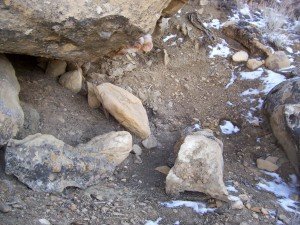 The bobcat is an adaptable, predatory member of the feline family found from southern Canada to Mexico. Bobcats are closely related to Canada lynx, though they generally consume a wider variety of prey and have a more southern distribution than lynx.
The bobcat is an adaptable, predatory member of the feline family found from southern Canada to Mexico. Bobcats are closely related to Canada lynx, though they generally consume a wider variety of prey and have a more southern distribution than lynx.
Description
Bobcats vary significantly in size and appearance based on the geographic area in which they are found. Adults can range from 10-40 lbs. Average sizes are larger in northern climates, and males are typically larger than females. They have a wide-looking face, sharp tufts on the tips of their ears, and a short, ‘bob’ tail. Coat color is usually tan to grey-ish brown, with a spotting pattern that helps camoflauge bobcats. Dark spots on white bellies, along with their thick winter coats, make bobcats from the northern Plains of the western U.S. and southern Canada bring top dollar in the fur market.
Reproduction, Diet and Habitat Requirements
The average life span of the bobcat is seven years. They breed in February-March, and the females give birth to 2-4 (up to six) young in the spring. The young are grown and usually disperse to new habitats in late fall.
Despite their relatively small size, bobcats are effective predators, and will capture and consume a variety of prey, from mice to deer. Bobcats are effective predators on deer fawns, and have even been documented taking down and killing large deer. In the early days, many states had bounties on bobcats to help minimize impacts to deer populations and domestic livestock.
Trapping the Bobcat
Bobcat trapping takes place throughout much of North America, but is most popular in areas of the Northern Plains of the American and Canadian West, where bobcat pelts usually command the highest value of all furbearers. In some boom years of the fur market, bobcat pelts can average more than $500 each in states like Montana, Utah, Nevada and others.
Bobcats are very visual predators, and trap sets that appeal to this visual nature will be the most effective at catching them. In addition to visual attractors, lure, scent and baits are important at attracting bobcats.
Unlike coyotes, bobcats will enter cages and sometimes push through bodygrip traps, so these can be effective capture methods. States like Colorado have strict trapping regulations that require the use of cages by many trappers. Still, the most effective method for bobcat trappers is making sets with foothold traps.
 In western states where trappers target bobcats, the most popular set includes a visual attractor (for instance, antelope hide hung from wire anchored to sandstone), bobcat bait/lure, and a walk-through path created by rocks, sticks or other terrain that forces the cat to step over the foothold trap. Bobcats can also be caught in sets for other furbearers like fox or coyotes, and some trappers are successful snaring bobcats.
In western states where trappers target bobcats, the most popular set includes a visual attractor (for instance, antelope hide hung from wire anchored to sandstone), bobcat bait/lure, and a walk-through path created by rocks, sticks or other terrain that forces the cat to step over the foothold trap. Bobcats can also be caught in sets for other furbearers like fox or coyotes, and some trappers are successful snaring bobcats.
Bobcat trapping can be very rewarding, and the trappers fortunate enough to target those beautiful western ‘cats are fortunate, for sure!